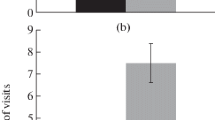Abstract
We studied the effect of low-intensity extrahigh-frequency (EHF) electromagnetic radiation (EMR) on the duration of a pain behavioral reaction in rats under conditions of experimental induction of tonic pain (formalin test). The antinociceptive effect of EHF irradiation was modulated by suppression of the activity of a few neurochemical systems resulting from the blockade of receptors of opioid peptides, α-and β-adrenoreceptors, receptors of dopamine and melatonin, as well as from inhibition of serotonin synthesis. We demonstrated that all the respective neurochemical systems are to a certain extent involved in the mechanisms underlying the analgesic action of EHF EMR. Within an early phase of pain stress, functioning of the opioidergic and noradrenergic systems and the effects of melatonin play leading roles, while the activity of the serotonergic system plays such a role within the second (tonic) phase.
Similar content being viewed by others
References
N. D. Devyatkov, M. B. Golant, and O. V. Betskii, Millimeter Wave and Their Role in the Living Processes [in Russian], Radio Svyaz’, Moscow (1991).
A. G. Pakhomov, H. K. Prol, S. P. Mathur, et al., “Search for frequency-specific effects of millimeter-wave radiation on isolated nerve function,” Bioelectromagnetics, l8, 324–334 (1997).
S. P. Sit’ko “Physics of living-new direction of fundamental natural science,” Vestn. Nov. Med. Tekhnol., 8, No. 1, 5–6 (2001).
O. V. Betskii, V. V. Kislov, and N. N. Lebedeva, Millimeter Waves and Living Systems [in Russian], Nauka, Moscow (2004).
A. E. Bessonov and M. V. Balakirev, “A technique for millimeter-wave therapy,” Vestn. Nov. Med. Tekhnol., 5, No. 2, 105–108 (1998).
V. F. Loboda, L. V. Zorya, and O. R. Boyarchuk, “Immunocontrolling action of EHF therapy in chronic gastroduodenal pathology in children,” in: Proceedings of the 1st National Congress of Physiatrists and Resortologists of Ukraine “Physical Factors in Medical Rehabilitation” [in Ukrainian], Khmil’nyk (1998), pp. 112–113.
Yu. A. Kholodov and N. N. Lebedeva, Reactions of the Human Nervous System on Electromagnetic Fields [in Russian], Nauka, Moscow (1992).
E. N. Chuyan, Neuroimmonoendocrine Mechanisms of Adaptation to the Action of Low-Intensity Extrahigh Frequency Electromagnetic Radiation [in Ukrainian], Abstr. of Doctoral Thesis, Biol. Sci., Kyiv (2004).
E. N. Chuyan and É. R. Dzheldubayeva, “Antinociceptive effects of low-intensity extrahigh-frequency electromagnetic radiation,” Neurophysiology, 38, No. 4, 277–285 (2006).
E. O. Bragin, Neurochemical Mechanisms of Regulation of Pain Sensitivity [in Russian], Publ. House of the Peoples’ Friendship University, Moscow (1991).
G. J. M. Maestroni, L. Flamgini, and A. Conti, “Biochemical and functional characterization of melatonin-induced opioids in bone marrow T-helper cells,” Neuroendocrinol. Lett., 17, 145–152 (1995).
É. B. Arashunyan, “A hormone of the epiphysis, melatonin, and its therapeutic potential,” Ross. Med. Zh., 13, No. 26, 1755–1760 (2005).
E. N. Chuyan, Effects of Millimeter Waves of Non-Thermal Intensity on the Development of Hypokinetic Stress in Rats with Different Individual Peculiarities [in Russian], Abstr. of Cand. Thesis, Biol. Sci., Simferopol’ (1992).
L. Santana Vega, Role of Individual Specificities of Motor Activity in the Development of Hypokinetic Stress in Rats [in Russian], Abstr. of Cand. Thesis, Biol. Sci., Simferopol’ (1991).
D. Dubuisson and S. G. Dennis, “The formalin test: a quantitative study of the analgesic effects of morphine, meperidine and brainstem stimulation in rats and cats,” Pain, 4, 161–164 (1997).
W. R. Martin, “Naloxone,” Ann. Int. Med., 85, No. 6, 765–768 (1976).
R. W. Fuller, “Serotonin uptake inhibitor,” Prog. Drug. Res., 45, 167–204 (1995).
E. V. Gura, E. V. Bagatskaya, and Yu. P. Limanskii, “Involvement of the serotonergic system in analgesia induced by the influence of low-intensity microwaves on an antipain acupuncture point,” Neurophysiology, 34, No. 4, 292–296 (2002).
W. Kirch, H. Kohler, H. Spahn, and E. Mutschler, “Interaction of cimetidine with metoprolol, propranolol, or atenolol,” Lancet, 2(8245), 531–532 (1981).
K. N. Loganovskii and K. L. Yur’ev, “Sermion. Review of proofs of clinical efficacy and safety,” Ukr. Med. Zh., 2, No. 46, 59–75 (2005).
D. P. Lawrence and P. N. Benitt, Clinical Pharmacology [Russian translation], Meditsina, Moscow (1993).
T. Sugawara, P. A. Sieving, P. M. Iuvone, and R. A. Bush, “The melatonin antagonist luzindole protects retinal photoreceptors from light damage in the rat,” Invest. Ophthalmol. Vis. Res., 39, No. 12, 2458–2465 (1998).
E. N. Chuyan and É. R. Dzheldubayeva, Mechanisms Underlying Antinociceptive Action of Low-Intensity Millimeter Radiation [in Russian], DIAIPI, Simferopol’ (2006).
Author’s Certificate No. 19243 of Ukraine, Computer Software for Recording, Processing, and Automated Data Analysis of the Duration and Frequency of Different Types of Behavioral Reactions in Animals [in Ukrainian], M. V. Lytsyuk and E. R. Dzheldubayeva, Published on January 18, 2007, Byul. No. 1.
M. Ebadi, P. Govitrapong, A. Phansuwan-Pujito, et al., “Pineal opioid receptors and analgesic action of melatonin,” Pineal Res., 24, No. 4, 193–200 (1998).
Collection of Conventions of Council of Europe: Ukrainian Version [in Russian], E. M. Vishnevskii (ed.), Parlament. Izd-vo, Kyiv (2000).
“The Law of Ukraine ‘On Protection of Animals from Inhumane Treatment’ No. 3447-IV from February 21, 2006” [in Ukraine], Vidomosti Verkhov. Rady Ukrainy, 27, 990 (2006).
M. Shibata, T. Ohkubo, H. Takahashi, and R. Inoki, “Modified formalin test: characteristic biphasic pain response,” Pain, 38, No. 3, 347–352 (1989).
T. Oyama, Y. Ueda, Y. Kuraishi, et al., “Dual effect of serotonin on formalin-induced nociception in the rat spinal cord,” Neurosci. Res., Ser. C, 25, 129–135 (1996).
M. Xu, M. Petraschka, J. McLaughlin, et al., “Neuropathic pain activates the endogenous opioid system in mouse spinal cord and induces opioid receptor tolerance,” J. Neurosci., 24, No. 19, 4576–4584 (2004).
Yu. M. Kulikovich and Z. A. Tamarova, “Role of opiate receptors in analgesia evoked by the action of low-intensity millimeter waves on an acupuncture point,” Med. Perspekt. 4, No. 3, 9–14 (1999).
V. P. Degtyarev, Systemic Mechanisms Underlying Pain and Anesthetization [in Russian], Izd-vo MMSI, Moscow (1993).
Author information
Authors and Affiliations
Corresponding author
Additional information
Neirofiziologiya/Neurophysiology, Vol. 39, No. 2, pp. 165–173, March–April, 2007.
Rights and permissions
About this article
Cite this article
Chuyan, E.N., Dzheldubayeva, É.R. Roles of different neurochemical systems in mechanisms underlying the antinociceptive effect of extrahigh-frequency electromagnetic radiation. Neurophysiology 39, 147–155 (2007). https://doi.org/10.1007/s11062-007-0020-y
Received:
Issue Date:
DOI: https://doi.org/10.1007/s11062-007-0020-y



